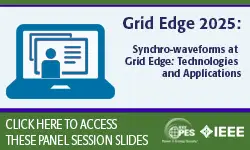-
Members: FreePES
IEEE Members: $25.00
Non-members: $40.00Pages/Slides: 92
Panel
14 Sep 2022
This panel session contains the following presentations:
1. Testing of Complicated Bus Bar Protection Using Smart Testing Methodology
In this paper, protection of a complicated bus arrangement with dual bus coupler and bus sectionalizer using low impedance differential protection applicable for very high voltages like 220kV and 400kV is discussed. In many power generation stations, several operational procedures are implemented to utilize the transfer bus as main bus and to facilitate maintenance of circuit breakers and current transformers (in each section) without shutting down the bay(s). Owing to this fact, the complications in operational philosophy have thrown challenges for the bus bar protection implementation. Many bus topologies allow any one of the main busses available in the station to be used as an auxiliary bus. In such system, pre-defined precautions and procedures are made as guidelines, which are followed before assigning any bus as an auxiliary bus. The procedure involves, shifting of links, changing rotary switches, insertion of test block and so on thereby causing unreliable operation. This kind of unreliable operations or inadvertent procedural lapse may result in isolation of the bus bar from the grid due to unpredictable operation of bus bar protection relay which is a commonly occurring phenomenon due to manual mistakes. With the sophisticated configuration and implementation of logics in modern intelligent electronic devices, the cumbersome procedures are totally eliminated and the operator is free to choose the transfer arrangement without compromising the protection need of a bus differential system for a reliable operation. This paper deals with the procedure to test the security logics for such special scenarios using Megger make SMRT, implemented in bus bar protection relay to ensure system stability and eliminate all the special operational precautions / procedure.
2. Method for Determining Background Distortion of a Real MV-Network Based on Measured Data
As part of the project EnEff: Stadt Campus Lichtwiese, a permanent Power Quality-Monitoring System has been installed in the medium-voltage network of the Campus Lichtwiese of Technical University of Darmstadt. The system enables measurement of harmonic distortion at each busbar of the network. The data measured is used to parametrise the network model of the campus for analysing its harmonic behaviour. In the course of this paper, the Campus Lichtwiese as well as the implemented monitoring system are presented. The latter is evaluated with regard to its measurement uncertainty. A method is introduced which, based on the measurement data and the network model of the campus, determines the background distortion at the point of common coupling (PCC) of the campus network, which in turn is used to parametrise the network model. Therefore the background distortion is firstly determined and secondly integrated into the model. The comparison between measurement and simulation at the PCC shows good conformity.
3. Protection Against Transient Overvoltages Caused by Intermittent Earth Faults in Unearthed Marine Power Distribution Networks
Intermittent earth faults may create overvoltage issues in unearthed and high-resistance earthed marine power distribution networks. Protection measures should be arranged to avoid equipment failures by limiting the overvoltages. This paper presents transient overvoltage analyses caused by intermittent earth faults in the unearthed marine networks. With an electrical model of a LNG carrier that is chosen to study, overvoltages are calculated under different fault durations, network configurations, and fault locations. Moreover, this paper discusses the effect of surge arresters in overvoltage mitigation and discharging energy. The study result shows that the proper installation of the protective device allows for managing the overvoltage level and energy within devices' ratings.
4. Mitigation on Sympathetic Inrush Current Phenomena Between Parallel-Connected Transformers Using PSCAD/EMTDC
In renewable energy sources, one of the most rapidly developing is wind energy. Wind turbine transformers are connected between the wind turbines and the distribution grid. Transformers have accessibility to play as key part in the overall power system. The magnetization of a wind-turbine transformer is frequently related with the inrush current phenomena. Magnetising inrush current perform as a start-up current which is develops in a transformer once it is turned on for the first times. The switched-on transformer is not only giving effects to the inrush current but it also had a significant impact on the parallel-connected transformers. This phenomenon called as sympathetic inrush current whereas it occurs once the transformer is turned on in a circuit while having another transformer that was previously energized. During the energization process, it has an unexpected saturation and once the transformer is saturated, transients develop, resulting in mal-operation of the protective relay and harmonic over-voltages. The magnitude and duration of the magnetising inrush current are dramatically changes when the phenomenon of sympathetic is occurred. In this research, the PSCAD software is utilized to develop a sympathetic inrush model and obtain the simulation results. According to simulation results, the proposed technique may efficiently identify sympathetic inrush. This paper examines the sympathetic inrush current phenomenon, as well as the factors that influence it and how to mitigate it.
5. Enhancement for Circuit Breaker Failure Protection in Transmission Substations
Currently, due to the growth in the industrial sector and the increase in the demand for power, the electrical power system has evolved. The modern power system is a complex system, which consists of power plants, transmission networks, different types of loads, and substations with advanced levels of automation, communication, and intelligent devices. The electrical substation is an essential component in power systems alongside generators, transmission systems, and distribution networks. This paper aims to investigate the transmission substation and its protection system. The Circuit Breaker Management (CBM) utilized in the substation is aimed at enhancing the Circuit Breaker Failure (CBF) protection. Therefore, CBF will continue to operate should a designated Circuit Breaker (CB) fail to isolate the fault. The outcomes of this paper aim to show that the proposed protection circuit is able to isolate the fault effectively and will protect the substation when the designated CB fails to operate.
1. Testing of Complicated Bus Bar Protection Using Smart Testing Methodology
In this paper, protection of a complicated bus arrangement with dual bus coupler and bus sectionalizer using low impedance differential protection applicable for very high voltages like 220kV and 400kV is discussed. In many power generation stations, several operational procedures are implemented to utilize the transfer bus as main bus and to facilitate maintenance of circuit breakers and current transformers (in each section) without shutting down the bay(s). Owing to this fact, the complications in operational philosophy have thrown challenges for the bus bar protection implementation. Many bus topologies allow any one of the main busses available in the station to be used as an auxiliary bus. In such system, pre-defined precautions and procedures are made as guidelines, which are followed before assigning any bus as an auxiliary bus. The procedure involves, shifting of links, changing rotary switches, insertion of test block and so on thereby causing unreliable operation. This kind of unreliable operations or inadvertent procedural lapse may result in isolation of the bus bar from the grid due to unpredictable operation of bus bar protection relay which is a commonly occurring phenomenon due to manual mistakes. With the sophisticated configuration and implementation of logics in modern intelligent electronic devices, the cumbersome procedures are totally eliminated and the operator is free to choose the transfer arrangement without compromising the protection need of a bus differential system for a reliable operation. This paper deals with the procedure to test the security logics for such special scenarios using Megger make SMRT, implemented in bus bar protection relay to ensure system stability and eliminate all the special operational precautions / procedure.
2. Method for Determining Background Distortion of a Real MV-Network Based on Measured Data
As part of the project EnEff: Stadt Campus Lichtwiese, a permanent Power Quality-Monitoring System has been installed in the medium-voltage network of the Campus Lichtwiese of Technical University of Darmstadt. The system enables measurement of harmonic distortion at each busbar of the network. The data measured is used to parametrise the network model of the campus for analysing its harmonic behaviour. In the course of this paper, the Campus Lichtwiese as well as the implemented monitoring system are presented. The latter is evaluated with regard to its measurement uncertainty. A method is introduced which, based on the measurement data and the network model of the campus, determines the background distortion at the point of common coupling (PCC) of the campus network, which in turn is used to parametrise the network model. Therefore the background distortion is firstly determined and secondly integrated into the model. The comparison between measurement and simulation at the PCC shows good conformity.
3. Protection Against Transient Overvoltages Caused by Intermittent Earth Faults in Unearthed Marine Power Distribution Networks
Intermittent earth faults may create overvoltage issues in unearthed and high-resistance earthed marine power distribution networks. Protection measures should be arranged to avoid equipment failures by limiting the overvoltages. This paper presents transient overvoltage analyses caused by intermittent earth faults in the unearthed marine networks. With an electrical model of a LNG carrier that is chosen to study, overvoltages are calculated under different fault durations, network configurations, and fault locations. Moreover, this paper discusses the effect of surge arresters in overvoltage mitigation and discharging energy. The study result shows that the proper installation of the protective device allows for managing the overvoltage level and energy within devices' ratings.
4. Mitigation on Sympathetic Inrush Current Phenomena Between Parallel-Connected Transformers Using PSCAD/EMTDC
In renewable energy sources, one of the most rapidly developing is wind energy. Wind turbine transformers are connected between the wind turbines and the distribution grid. Transformers have accessibility to play as key part in the overall power system. The magnetization of a wind-turbine transformer is frequently related with the inrush current phenomena. Magnetising inrush current perform as a start-up current which is develops in a transformer once it is turned on for the first times. The switched-on transformer is not only giving effects to the inrush current but it also had a significant impact on the parallel-connected transformers. This phenomenon called as sympathetic inrush current whereas it occurs once the transformer is turned on in a circuit while having another transformer that was previously energized. During the energization process, it has an unexpected saturation and once the transformer is saturated, transients develop, resulting in mal-operation of the protective relay and harmonic over-voltages. The magnitude and duration of the magnetising inrush current are dramatically changes when the phenomenon of sympathetic is occurred. In this research, the PSCAD software is utilized to develop a sympathetic inrush model and obtain the simulation results. According to simulation results, the proposed technique may efficiently identify sympathetic inrush. This paper examines the sympathetic inrush current phenomenon, as well as the factors that influence it and how to mitigate it.
5. Enhancement for Circuit Breaker Failure Protection in Transmission Substations
Currently, due to the growth in the industrial sector and the increase in the demand for power, the electrical power system has evolved. The modern power system is a complex system, which consists of power plants, transmission networks, different types of loads, and substations with advanced levels of automation, communication, and intelligent devices. The electrical substation is an essential component in power systems alongside generators, transmission systems, and distribution networks. This paper aims to investigate the transmission substation and its protection system. The Circuit Breaker Management (CBM) utilized in the substation is aimed at enhancing the Circuit Breaker Failure (CBF) protection. Therefore, CBF will continue to operate should a designated Circuit Breaker (CB) fail to isolate the fault. The outcomes of this paper aim to show that the proposed protection circuit is able to isolate the fault effectively and will protect the substation when the designated CB fails to operate.
Chairs:
Fatimah Salim


